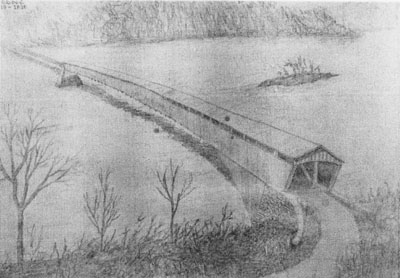Many of the covered bridges in Lancaster County utilize an architectural style called the “Burr Truss” or “Burr Arch-Truss”. It’s easy to see the arch, but what is the “Burr”? Does it refer to the rough edges of the woodwork? Or maybe it’s the sound that your car makes as you drive over the bridge?
None of the above. The term refers to the American bridge builder who patented this bridge-building technique. His name was Theodore Burr, and he patented his innovation in 1817. The Burr Arch-Truss consists of multiple kingposts flanked by curved arches that are set in the abutments below the bridge.
Theodore Burr was born in the Connecticut colony in 1771. His father was a miller and mill wright. Some sources claim that Theodore was a cousin to vice-president Aaron Burr, but this cannot be confidently established. Theodore left Connecticut and moved to the New York frontier in 1794 where he built a grist mill in the new town of Oxford on the Chenango River. He built his first bridge in 1800 to provide access to his mill. That first bridge was likely a simple trestle bridge.
Burr must have found that bridge building was a better occupation than milling, because he soon built another bridge in New York over the Schoharie Creek at Esperance. Then he went on to build five more bridges in the state between 1802 and 1805. In those days, you didn’t attend university to get an engineering degree, you just built a bridge with the skills you had and learned from experience whether the design was successful or not.
In 1804, he boldly built a bridge across the Delaware River from Trenton, NJ to Morrisville, PA. This bridge consisted of five spans for a total of 1,064 feet. It was constructed of laminated tied arches with a level deck hung from chains. It was partially covered. It opened on January 30, 1806, and remained in service until 1875.
He then moved to Pennsylvania and began building bridges over the mighty Susquehanna. His first bridge across the Susquehanna was on the North Branch between Northumberland and Sunbury. It was constructed in two halves or “tandems”. The west tandem between Northumberland and Shamokin Island had four spans for a total of 848 feet. The east tandem between Shamokin Island and Sunbury had another four spans for a total of 976 feet. It was called a “camelback” bridge because the deck rose and fell with the underdeck arches. This bridge also utilized trussed arches above the deck. Construction began in 1812 and opened in a partially complete state in 1814. Two spans of the west tandem were destroyed by a flood in 1839 and rebuilt only to be destroyed again in 1846.
Burr put a bid on the Columbia-Wrightsville bridge which would become the longest covered bridge ever built. He lost that bid to Jonathan Walcott.
Burr built a camelback bridge at Harrisburg between 1813 and 1817. It also had two tandems with Forster’s Island (now City Island) as the connection point. A flood destroyed the East Tandem in 1846. The West Tandem remained until it was torn down in 1912.
In 1815, Burr was contracted to build a bridge over the Susquehanna between Lancaster and York Counties at the site of McCall’s Ferry. This was at the time one of the narrowest points of the river. However, one of America’s most distinguished architects, Benjamin Henry Latrobe, had surveyed the lower Susquehanna fourteen years prior. Commenting on the McCall’s Ferry location, Latrobe noted that the river rises rapidly after a rainfall upstream, and he concluded that it would never be possible to build a safe bridge at that place. Either Burr didn’t know about Latrobe’s assessment, or he didn’t care, because he constructed a fully covered, arch-truss bridge with two spans for a total of 607 feet at this location. The main span, which measured 360 feet was the longest single span wooden covered bridge ever built. The arches were assembled while the river was frozen, allowing the workers to slide the heavy beams into place across the ice. Construction was completed in 1817 but it didn’t take long for the river to exact its revenge. The bridge was demolished by an ice jam on March 3, 1818. The bridge was never rebuilt, and the ferry returned to service.

In 1817-1818, Burr built another bridge further down the river between Rock Run and Port Deposit, Maryland. It was an 18-span arch-truss bridge intercepted by islands in the middle section. This was likely the first bridge built with his newly patented design. Six of the spans were damaged by fire in 1829 but rebuilt by Lewis Wernwag (Burr died in 1822 at the age of 51). The bridge was severely damaged by a flood in 1846 and subsequently repaired. Two spans of the western section were destroyed in 1854, this time by a cattle stampede. The law stated that no more that 10 animals should cross together within a space of 50 yards. There were 110 head of cattle on the second and third spans when the bridge gave way. Only 13 of the cattle managed to get off, the rest went into the water. The bridge was abandoned after that and it was destroyed by a flood in 1857.
The final bridge attributed to Burr himself was a bridge over the Swatara Creek, a two-span Burr arch-truss built in 1822, the year he died. Burr never was able to profit from his patent. His son Henry tried to enforce the patent but was mostly unsuccessful.
The next time you drive, or better walk, across one of the county’s covered bridges, stop to appreciate the innovation of one of the nation’s best known early bridge builders.
Information for this article came from the book by Ronald G. Knapp & Terry E. Miller, Theodore Burr and the Bridging of Early America, AMZ Publishing Pros, 2023.
